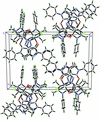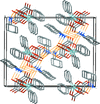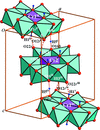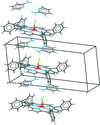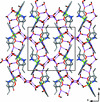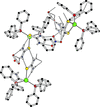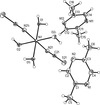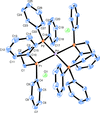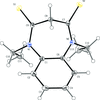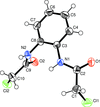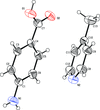issue contents
February 2015 issue

Cover illustration: Methohexital is a short-acting barbiturate derivative. The molecule contains two asymmetric centres and can exist as two diastereomeric enantiomer pairs. Its stereoisomerism is known to affect the anaesthetic activity and possible side effects of the drug. The present crystal structure determination revealed the (RbSh)/(SbRh) racemate. In the crystal, N-H O=C hydrogen-bonded molecules are linked into an inversion dimer with an R22(8) motif. The packing features are different in comparison with the previously reported (SbRh) form. See: Gelbrich & Griesser [Acta Cryst. (2015). E71, 206-209].
O=C hydrogen-bonded molecules are linked into an inversion dimer with an R22(8) motif. The packing features are different in comparison with the previously reported (SbRh) form. See: Gelbrich & Griesser [Acta Cryst. (2015). E71, 206-209].
research communications
Download citation


Download citation


In the crystal of the title molecular salt, the pyridinium cation and the 3-hydroxy-2,4,6-trinitrophenolate anion are linked through bifurcated N—H⋯(O,O) hydrogen bonds forming an  (6) ring motif. Impact, friction sensitivity tests and TGA/DTA studies on this compound imply that it is an insensitive high-energy-density material.
(6) ring motif. Impact, friction sensitivity tests and TGA/DTA studies on this compound imply that it is an insensitive high-energy-density material.
CCDC reference: 1006492
Download citation


Download citation


In a new coumarin derivative obtained from the reaction of 3-acetyl-4-hydroxy-2H-chromen-2-one with bromine in acetic acid, the hydroxy group in involved in an intramolecular O—H⋯O hydrogen bond. In the crystal, π–π interactions between the rings of the bicycle pack molecules into stacks along the b axis.
CCDC reference: 1040655
Download citation


Download citation


In the title copper(II) complex containing chloride and a derivative of 3-methyl-1-phenyl-4-hydrazopyrazolin-5-one, acting as a tridentate ligand, the CuII atom is in a slightly distorted square-planar coordination. Molecules stack in columns along the c axis.
CCDC reference: 1040070
Download citation


Download citation


The predominant intermolecular interactions for triazole rings involve the acidic hydrogen in the third position as shown by the title compound, 2,6-bis[(1H-1,2,4-triazol-1-yl)methyl]pyridine, (I), and the salt 1,1′-[pyridine-2,6-diylbis(methylene))bis(4-methyl-1H-1,2,4-triazol-4 -ium] iodide triiodide, (II).
Download citation


Download citation


In the title compound, the indole ring system makes the dihedral angles of 84.89 (7) and 57.32 (5)° with the phenyl rings. In the crystal, molecules are linked by C—H⋯O hydrogen bonds.
CCDC reference: 1040926
Download citation


Download citation


The CuII ion in the title compound shows a slightly distorted octahedral coordination geometry with four N atoms of the azamacrocyclic ligand and two perchlorate anions. In the crystal, molecules are linked by N–H⋯O and C–H⋯O hydrogen bonds, forming a three-dimensional network.
CCDC reference: 1040897
Download citation


Download citation


The mixed solvated salt 4-(2-chlorodibenzo[b,f][1,4]oxazepin-11-yl)piperazin-1-ium acetate–acetic acid–cyclohexane (2/2/1), crystallizes with one molecule of protonated amoxapine (AXPN), an acetate anion and a molecule of acetic acid together with half a molecule of cyclohexane. In the crystal, the various components are linked via N—H⋯O and O—H⋯O hydrogen bonds, forming a layered structure with the solvent molecules occupying the spaces between the layers.
CCDC reference: 1040948
Download citation


Download citation


2-Picolinoylhydrazone with a 2-quinolyl substituent on the imine-C atom coordinates in the neutral Z form to a RuII(bpy)2 fragment via the amide-O and imine-N atoms, affording a planar five-membered chelate ring, and its hydrazone N—H group forms an intramolecular hydrogen bond with the uncoordinating quinoline-N atom.
CCDC reference: 1042209
Download citation


Download citation


Two heterometallic decavanadate(V) hydrated salts with tetramethylammonium and [tris(hydroxymethyl)methyl]ammonium counter-cations have been synthesized under mild reaction conditions in an aqueous medium. Both polyanions present two [Mn(OH2)5]2+ complex units bound to the decavanadate cluster through oxide bridges.
Download citation


Download citation


In the title salt, (CyNH3)2[Sn(Ph2)(C2O4)2] (Cy is cyclohexyl and Ph is phenyl), the SnPh2 moiety is chelated by two oxalate anions, leading to a cis arrangement within the distorted octahedral coordination sphere of the SnIV atom.
CCDC reference: 1040398
Download citation


Download citation


In contrast to most other structures of transition metal orthophosphates with composition M3-xM'x(PO4)2·H2O, the three metallic sites in the structure of Mn2Zn(PO4)2·H2O show no statistical disorder.
CCDC reference: 1042563
Download citation


Download citation


K2[H7CrIIIMo6O24]·8H2O contains a symmetric hydrogen bond in which the H atom does not lie on a crystallographic centre of symmetry. The structure has been redetermined in order to locate the position of the seventh H atom.
CCDC reference: 1042715
Download citation


Download citation


The crystal packing of the compound is described by an intermolecular arrangement with the molecules as interlaced layers in a zigzag fashion, denoting interacting self-complementary dimers mainly by the localization of weak hydrogen bonds in a head-to-tail arrangement.
CCDC reference: 1042952
Download citation


Download citation


In the title compound, the chlorido(5,10,15,20-tetraphenylporphyrinato)manganese(III) complex and the hydrogen-bonded dimer of 2-aminopyridine molecules are linked together by weak N—H⋯Cl hydrogen bonds into chains along the a axis.
CCDC reference: 1042885
Download citation


Download citation


Crotonaldehyde semicarbazone and crotonaldehyde thiosemicarbazone show the same E conformation around the imine C=N bond. Each molecule has an intramolecular N—H⋯N hydrogen bond, which generates an S(5) ring. Intermolecular N—H⋯O hydrogen bonds in the semicarbazone link the molecules into layers parallel to the bc plane, while weak intermolecular N—H⋯S hydrogen bonds in the thiosemicarbazone link the molecules into chains propagating in [110].
Download citation


Download citation


The NiII ion in the title compound shows a slightly distorted octahedral coordination geometry with four N atoms of the azamacrocylic ligand and two N atoms of the 5-methyl-1H-tetrazolate ions. In the crystal, molecules are connected by an N—H⋯N hydrogen bond, forming a supramolecular sheet structure.
CCDC reference: 1043241
Download citation


Download citation


In the title compound, the planes of the benzene and phenyl rings are inclined to the thiophene ring by 35.2 (4) and 57.7 (3)°, respectively, while the planes of the two aryl rings are almost normal to one another, making a dihedral angle of 86.4 (6)°. In the crystal, molecules are linked by C—H⋯O hydrogen bonds, forming chains propagating along the a-axis direction.
CCDC reference: 1042320
Download citation


Download citation


The title compound was unwittingly obtained from the slow evaporation of a saturated solution of commercial benserazide hydrochloride. The molecule is composed of two planar 4-methylquinoline aromatic moieties, almost perpendicular to each other, bridged by an O atom. The supramolecular organization consists of a π-bonded chain.
CCDC reference: 1034614
Download citation


Download citation


The title compound consists of two planar halves. There is one half-molecule in the asymmetric unit, the whole molecule being generated by twofold rotation symmetry. The crystal structure has wide channels of 5–6 Å in diameter extending along the c-axis direction. The molecules are associated into a three-dimensional network supported by some weak C—H⋯O hydrogen bonds and C—H⋯π interactions.
CCDC reference: 1007641
Download citation


Download citation


The two molecules of 2-(2-aminophenyl)-1,3-benzoxazole in the asymmetric unit feature an intramolecular N—H⋯N hydrogen bond, which closes an S(6) ring and therefore establishes a syn relationship for the N atoms. In the crystal, molecules are linked by N—H⋯N hydrogen bonds, generating [100] chains containing alternating A and B molecules.
CCDC reference: 1042858
Download citation


Download citation


In the crystal of the title compound, molecules are linked by pairs of N—H⋯Nnitrile hydrogen bonds, forming inversion dimers with an  (12) ring motif. The dimers are linked by C—H⋯π and π–π interactions [centroid–centroid distance = 3.7211 (12) Å], forming a three-dimensional framework.
(12) ring motif. The dimers are linked by C—H⋯π and π–π interactions [centroid–centroid distance = 3.7211 (12) Å], forming a three-dimensional framework.
CCDC reference: 1042906
Download citation


Download citation


The NiII atom in the title compound is in a distorted octahedral coordination geometry with two N atoms of the phenanthroline ligand, two O and one N atom of the 2-[(2-hydroxybenzyl)amino]-4-methylpentanoic acid ligand and one water molecule. In the crystal, the complex molecules and solvate water molecules are associated via O—H⋯O hydrogen bonds into a three-dimensional network.
CCDC reference: 1044097
Download citation


Download citation


The structures of two butenolide derivatives are reported. The conformations are differ largely in the orientation of the amide carbonyl atom.
Download citation


Download citation


The CuII ion in the title compound shows a distorted octahedral coordination environment defined by four N atoms of the azamacrocylic ligand in the equatorial plane and two O atoms of the isonicotinate ions in the axial sites. In the crystal, the molecules are connected by hydrogen bonds and π–π interactions, forming rods parallel to [001].
CCDC reference: 1044260
Download citation


Download citation


N—H⋯O=C bonded molecules of the title compound are linked into a inversion dimer with an  (8) motif.
(8) motif.
CCDC reference: 1044166
Download citation


Download citation


In the title complex, the CrIII ion is coordinated by two nearly perpendicular pyridine-2,6-dicarboxylate (pydc) dianions acting as tridentate ligands through the pyridine N atoms and two of the O atoms of each carboxylate group, in a distorted octahedral geometry. The ammonium cation is linked to non-coordinating carbonyl O atoms from neighboring pydc groups through N—H⋯O hydrogen-bonding interactions.
CCDC reference: 1044324
Download citation


Download citation


The title compounds are the product of a tandem `pincer' Diels–Alder reaction consisting of [2 + 2] cycloadditions between benzo[c]furan and cyclopentanone. The molecules are linked via weak C—H⋯O intermolecular hydrogen bonds, which generate  (16) ring motifs in compound (I) and C(8) chains in compound (II). In both structures, the crystal packing also features C—H⋯π interactions.
(16) ring motifs in compound (I) and C(8) chains in compound (II). In both structures, the crystal packing also features C—H⋯π interactions.
Download citation


Download citation


In the title salt, crystalline water molecules serve as donors for the weak intermolecular O—H⋯O and O—H⋯Br hydrogen bonds which link adjacent polymeric chains.
CCDC reference: 1044327
Download citation


Download citation


In the nitrate salt of this AgI complex, the AgI atom is coordinated by two S atoms of thiourea and two P atoms of triphenylphosphane in a distorted tetrahedral geometry. In the crystal, the component ions are linked by C—H⋯O, C—H⋯S, N—H⋯O and N—H⋯S hydrogen bonds, generating (10-1) sheets.
CCDC reference: 1044766
Download citation


Download citation


Bulky isopropyl substituents introduce steric hindrance within the molecule. The organic cation and perchlorate anion are linked by N—H⋯O hydrogen bonding. In the crystal, molecules form separated layers resulting in a low crystal density of 1.18 Mg m−1.
CCDC reference: 1045018
Download citation


Download citation


The structures of two solvates (water and methanol) of the facial isomer of (Me3P)3RhCl3 are reported and compared with previously published facial (Me3P)3IrCl3 solvates with which they are isostructural and isomorphous.
Download citation


Download citation


The title molecular salt, obtained by the reaction of sulfamic acid with 2-amino-5-nitropyridine, is the result of a proton transfer from sulfamic acid to the N atom of the pyridine ring. In the crystal, the cations and anions are linked by a number of N—H⋯O and N—H⋯N hydrogen bonds, forming sheets lying parallel to (100).
CCDC reference: 1042506
Download citation


Download citation


The crystal structure of tetrawickmanite, a tetragonal hydroxide-perovskite mineral, has been determined for the first time by means of single-crystal X-ray diffraction. It is characterized by alternating corner-linked [Mn2+(OH)6] and [Sn4+(OH)6] octahedra whose sense of rotation varies along c, in contrast to its dimorph, the cubic wickmanite.
CCDC reference: 1045459
Download citation


Download citation


In the crystal of the title compound, which crystallized with two independent molecules (A and B) in the asymmetric unit, the A and B molecules are linked via pairs of N—H⋯S hydrogen bonds, forming dimers with an  (8) ring motif. The dimers are linked via pairs of C—H⋯O hydrogen bonds and C—H⋯π interactions, forming ribbons propagating along [100].
(8) ring motif. The dimers are linked via pairs of C—H⋯O hydrogen bonds and C—H⋯π interactions, forming ribbons propagating along [100].
CCDC reference: 1043887
Download citation


Download citation


The title compound belongs to the large family of heterodinuclear phosphide-bridged complexes. The Fe—Pt bond is of 2.7738 (4) Å and there is an unprecedented arrangement of the silyl ligand in a trans-position with respect to the metal–metal vector in the family of phosphide-bridged iron–platinum heterobimetallics.
CCDC reference: 1045140
Download citation


Download citation


The first ferrocenylcarbonitrile copper complex is reported. The structure consists of two CuI ions complexed by ferrocenediyl-1,1′-dicarbonitrile forming a paddle-wheel with two acetone molecules, with one coordinating on top of one trigonal–planar-coordinated copper ion, and the other as a packing solvent.
CCDC reference: 1045804
data reports
metal-organic compounds
Download citation


Download citation


Download citation


Download citation


Download citation


Download citation


Download citation


Download citation


Download citation


Download citation


Download citation


Download citation


Download citation


Download citation


Download citation


Download citation


Download citation


Download citation


Download citation


Download citation


Download citation


Download citation


Download citation


Download citation


Download citation


Download citation


Download citation


Download citation


Download citation


Download citation


Download citation


Download citation


Download citation


Download citation


Download citation


Download citation


Download citation


Download citation


organic compounds
Download citation


Download citation


Download citation


Download citation


Download citation


Download citation


Download citation


Download citation


Download citation


Download citation


Download citation


Download citation


Download citation


Download citation


Download citation


Download citation


Download citation


Download citation


Download citation


Download citation


Download citation


Download citation


Download citation


Download citation


Download citation


Download citation


Download citation


Download citation


Download citation


Download citation


Download citation


Download citation


Download citation


Download citation


Download citation


Download citation


Download citation


Download citation


Download citation


Download citation


Download citation


Download citation


Download citation


Download citation


Download citation


Download citation


Download citation


Download citation


Download citation


Download citation


Download citation


Download citation


Download citation


Download citation


Download citation


Download citation


Download citation


Download citation


Download citation


Download citation


Download citation


Download citation


Download citation


Download citation


Download citation


Download citation


Download citation


Download citation


Download citation


Download citation


Download citation


Download citation


Download citation


Download citation


Download citation


Download citation


Download citation


Download citation


Download citation


Download citation


Download citation


Download citation


Download citation


Download citation




 journal menu
journal menu













